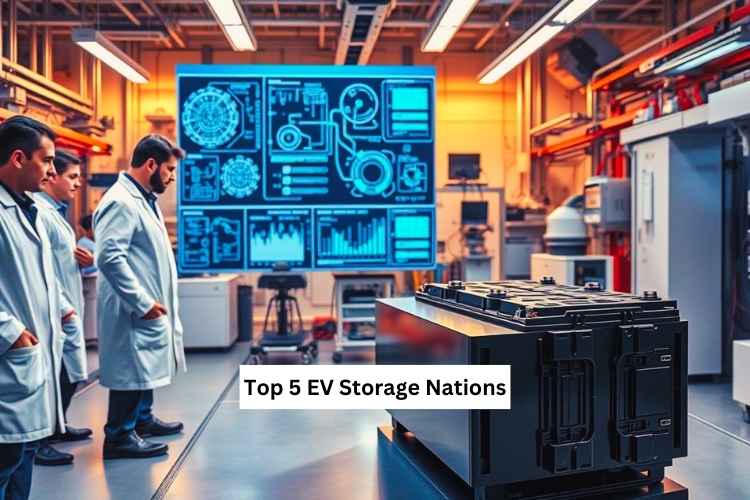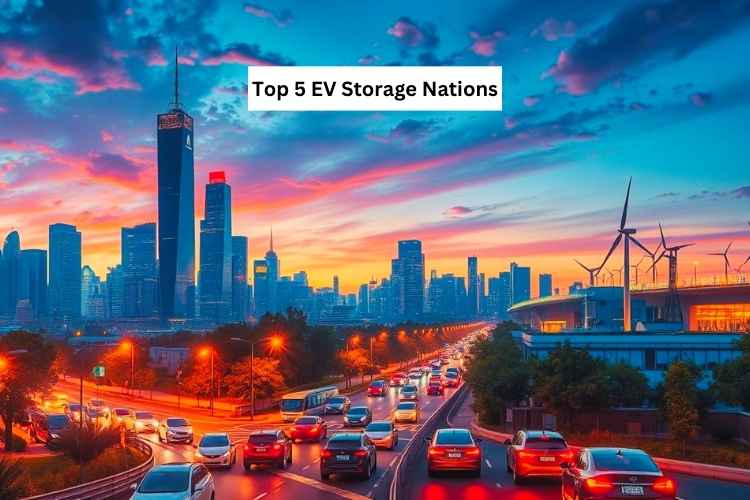Top 5 EV Storage Nations: Did you know China makes over 70% of the world’s lithium-ion batteries? These batteries power electric vehicles (EVs) everywhere. This shows a big race to lead in energy storage, which is key for countries like India wanting to grow sustainable transport.

I’ve been following renewable energy trends closely. I’ve seen how new energy storage tech is changing industries. Countries ahead in electric vehicles and battery tech are doing more than making cars. They’re changing energy policies, cutting emissions, and creating jobs. For India, learning from these leaders could speed up our move to cleaner energy.
Table of Contents
Top 5 EV Storage Nations: Key Takeaways
- Top nations dominate 80% of global battery production, influencing EV adoption worldwide.
- Battery technology breakthroughs lowered costs, making electric vehicles more accessible.
- Renewable energy integration with energy storage cuts reliance on fossil fuels.
- India’s EV growth needs lessons from infrastructure investments in nations like Norway.
- Energy storage innovation drives sustainable transportation and grid stability.
Understanding the Future of Energy: Top 5 EV Storage Nations

Every nation profiled here offers a blueprint for advancing electric vehicle technology. Their strategies in battery manufacturing and EV infrastructure reveal pathways to accelerate the energy transition. Let’s break down how each country’s approach could inspire global progress.
China: The Manufacturing Powerhouse
China’s factories dominate battery manufacturing, producing 70% of global lithium-ion cells. Government subsidies and EV infrastructure investments have made them a lynchpin of the global EV market. Their scale ensures cost-efficient battery production for mass adoption.
United States: Innovation and Investment
U.S. tech hubs like California blend R&D with venture capital. Startups and giants like Tesla are refining battery tech while expanding EV charging networks. Public-private partnerships are key to scaling clean energy adoption.
Norway: The European Leader
Norway’s 85% EV market share stems from tax exemptions and clean energy grids. As
“EV adoption here proves policy and infrastructure can drive the energy transition,”
says a 2023 International Energy Agency report. Their success hinges on charging networks powered by hydropower.
South Korea: Battery Technology Pioneer
South Korea’s LG Energy Solution and SK On are trailblazing solid-state battery tech. Their battery manufacturing expertise positions them to dominate next-gen storage solutions, aiming for 50% global market share by 2030.
Japan: Efficiency and Infrastructure Excellence
Japan’s compact cities prioritize EV infrastructure like ultra-fast charging stations. Toyota and Panasonic’s R&D in compact battery packs optimize space for urban driving needs, balancing efficiency with clean energy goals.
Top 5 EV Storage Nations: How These Nations Are Transforming Global Energy Landscapes
China, the U.S., Norway, South Korea, and Japan are leading in EV storage innovation. Their actions are making climate solutions move faster. Let’s explore how their choices are changing energy systems worldwide:
- Battery prices drop: Mass production in these nations slashes costs, making electric mobility affordable globally.
- Policy shifts spread: Norway’s EV incentives inspire India and other nations to adopt green mobility policies.
- Grids get smarter: Japan’s energy efficiency tech helps stabilize power networks, reducing blackouts.
These changes are not just technical—they’re also geopolitical. South Korea’s partnerships with African nations, for example, expand sustainable development access to emerging markets. Even India’s auto industry is adapting: Tata Motors recently partnered with South Korean firms to build cheaper EV batteries.
“Their progress isn’t just about cars—it’s a blueprint for cleaner energy systems,” says Dr. Rajesh Kumar, energy analyst at IEEFA.
By pushing for electric mobility, these countries are changing energy trade dynamics. Oil-dependent economies now face pressure to diversify, while solar-rich nations like India gain opportunities. Their innovations are a blueprint for a greener future.
Conclusion on Top 5 EV Storage Nations
India needs to learn from countries leading in electric vehicles (EVs) to achieve sustainable energy. China and South Korea show how national energy policies can boost EV manufacturing. Norway’s smart grid integration models help balance renewable energy.
India can speed up its carbon reduction goals by partnering with tech giants like Tesla or BYD. This would create jobs and reduce imports, improving energy security.
India faces unique challenges like urban congestion and rural electrification. Learning from Japan’s focus on efficiency, India could invest in microgrid projects. The U.S. tax incentives show how subsidies can encourage EV adoption.
India’s National Electric Mobility Mission could be stronger by following global battery recycling and grid stability standards. Policymakers should make regulations easier to attract foreign investment, like South Korea’s tech hubs.
By combining solar energy with EV charging, India can create a circular system. This supports both mobility and clean power. The future depends on blending local needs with international best practices for a strong energy future.
Bhakti Rawat is a Founder & Writer of InsureMyCar360.com. This site Provides You with Information Related To the Best Auto Insurance Updates & comparisons. 🔗
